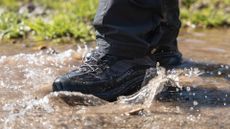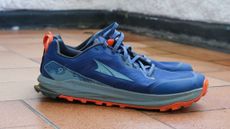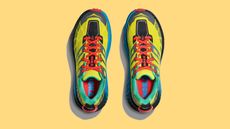Hiking & Walking
The latest Hiking & Walking breaking news, comment, reviews and features from the experts at T3
-

Vivobarefoot’s new hiking boot arrives with upgrades you can’t see (but you’ll definitely feel)
The Tracker Textile AT II returns with a new Shadow Green colourway
By Matt Kollat Published
-

Shoppers say this The North Face shoe has “great spring” and “all-day comfort” – and now it's a lot cheaper in John Lewis's Black Friday sale
The Altamesa 300 is perfect for walking and running, and now it's only £88 at the retailer
By Matt Kollat Published
-

Merrell Moab Speed 2 Mid review: comfort king of the crossover boots
A lightweight, cushioned hybrid that finally gives this in-between style a purpose
By Matt Buckley Last updated
-

Adidas Terrex Skychaser GORE-TEX review: Stability king
Waterproof, grippy and surprisingly stable: the Skychaser GTX does it all
By Matt Buckley Last updated
-

How to make your hiking boots last longer: 5 mistakes to avoid
Our hiking boots can take a battering all-year round, here’s how to care for them so they’re ready to tackle every trail
By Bryony Firth-Bernard Published
-

5 hiking essentials every beginner needs, says an outdoor expert
If you’re new to hiking, don't head out without these five things
By Bryony Firth-Bernard Published
-

Outdoor expert shares 4 tips to help you recover faster after a hike
Body feeling battered post-hike? Here's what you need to do
By Bryony Firth-Bernard Published
-

Walk fast! Amazon’s slashed the world’s best-selling hiking boot to less than £100
The Moab Speed 3 is your perfect all-terrain hiking shoe for Autumn/Winter
By Bryony Firth-Bernard Published
-

HOKA just turned its carbon-plated trail runner into a hyper cushy hiking shoe
The Mafate X Hike brings carbon plates, Vibram grip and RECCO safety to the trail in HOKA’s boldest outdoor launch yet
By Matt Kollat Published
-

This Montane waterproof jacket never lets water in, and it’s currently on sale
Need a new waterproof to keep you bone dry whilst out on the trails? The Cetus Lite is that jacket
By Bryony Firth-Bernard Published
-

Autumn hiking is better: 5 things you’ll only experience in fall
From spectacular scenery to quieter trails, autumn is the perfect time to lace up your hiking boots and get outdoors
By Bryony Firth-Bernard Published
-

These Salomon hiking boots were great on long hikes, but struggled when the mud hit
I went to the Lake District to test the Salomon X Ultra 5 Mid boots
By Matt Buckley Published
-

Vivobarefoot’s camel leather boot is made for deserts, but I'd wear it anywhere
Vivobarefoot completes its ESC series with the Desert ESC Boot made for modern nomads and urban explorers alike
By Matt Kollat Published
-

I tested the Lowa Maddox Pro GTX Lo for a month, and now they are my go-to travel hikers
Lowa's lightweight, waterproof walking shoes blend trail-ready grip with a travel-friendly build
By Jamie Carter Published
-

Struggling to hit 10,000 steps a day? This Prime Day shoe deal could change that
Merrell's T3 Awards-winning walking shoe is comfortable and waterproof, and now it's £60 off
By Matt Kollat Published
-

HOKA just launched a new carbon racer shoe that’s built for speed – and comfort
The Rocket X 3 kicks bring a more stable, supportive take on the race-day super shoe
By Lee Bell Published
-

HOKA just dropped a fresh shoe that support-focused runners are going to love
The brand's best-loved support shoe just got a snazzy upgrade with its eighth iteration now available
By Lee Bell Published
-

Best walking shoes for men 2025: footwear from casual strolls to adventurous treks
The best walking shoes for men combine comfort, durability, and performance for every step
By Matt Kollat Last updated
-

I test walking shoes for a living, and the pair I’d recommend for Glasto is now less than £100
These best-sellers are comfy, stylish, breathable and even waterproof
By Bryony Firth-Bernard Published
-

This ultralight fastpack became my favourite trail running bag (and it’s not even waterproof)
Gossamer’s Grit 28L is a brilliant do-it-all pack for ultralight adventures
By Matt Kollat Published
-

12 packable hiking essentials you didn't know needed in 2025
Don’t let your gear weigh you down
By Matt Kollat Published
-

The Altra Lone Peak 9+ trail shoes didn’t work for my marathon, but they’re my new hiking go-to
It’s not the trail runner I hoped for, but it’s an incredible hiker
By Matt Kollat Published
-

I swapped my weekly run for Japan's viral walking technique – the results were surprising
Not a fan of running? Then walk.
By Lucy Miller Published
-

Best hiking boots for men 2025: trail-tested footwear for every adventure
From lightweight designs to robust options for rugged adventures, discover the top men's hiking boots, offering exceptional comfort, durability, and support for all terrains
By Matt Kollat Last updated
-

YETI’s new Cayo Backpack doesn’t mess around
The toughest everyday backpack YETI has ever made
By Matt Kollat Published
-

The North Face’s new hiking boots are built for terrain that eats other shoes alive
The Offtrail Hike collection is a rugged new capsule made to handle the kind of trails your regular boots fear
By Matt Kollat Published
-

Sandals on the trail: smart swap or risky move?
Hiking sandals are making a comeback as an outdoor staple, but are they really adventure-ready?
By Bryony Firth-Bernard Published
-

Hoka just brought back a cult-classic trail shoe, but not for the reason you think
The Speedgoat 2 returns with its OG silhouette and retro vibes intact
By Matt Kollat Published
-

VEJA just turned its toughest trail shoe into a style statement with a little help from BUFF
The BUFF x VEJA Fitz Roy is a bold, eco-conscious hiking shoe built for real adventures
By Matt Kollat Published
